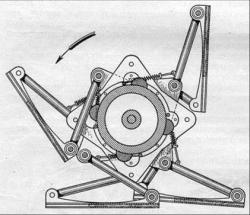 |
Hornsby Tractor, 1905. David Roberts filled patent in 1905 : ‘Improvements for Connected Road Locomotives and Vehicles' : GB190523736 for a tractor equipped with chain tracks which was improved in 1909. Between these dates, a Hornsby tractor with two tracks steered by different speeds between them, was built in 1905 and tested. Demonstrations went further from 1908 to 1910 at Adelshot. Interesting evolution of the vehicle could be seen. However, the Royal Artillery disagreed. The patent was sold to Holt Manufacturing Company.
In total, 5 Hornsby caterpillar machines were made, 3 oil powered engines for gun haulage, one small Schneider auto, and a steam crawler. One oil crawler survives in operational condition at The Tank Museum, Bovington. The first commercial film was made. Four vehicles were sold to the War Office to tow artillery. https://www.practicalmachinist.com/vb/antique-machinery-and-history/ot-crawler-tractors-196276/, http://www.youtube.com/watch?v=7TGgLrS9Sfs, https://en.wikipedia.org/wiki/David_Roberts_(engineer), https://en.wikipedia.org/wiki/Richard_Hornsby_%26_Sons
|
 |
Hornsby N° 1 Caterpillar in 1905. It was the first practical chain-track to be powered, despite appearances, by an oil engine. From 'Devil's Chariots', John Glanfield, 2001. https://www.practicalmachinist.com/vb/antique-machinery-and-history/ot-crawler-tractors-196276/index10.html
|
 |
Hornsby Little Caterpillar, 1909, of Bovington Museum, still theoretically in full working order although it did not run for about twenty years. Roberts's chain-track played no direct part in the development of the tank, although Lt-Col. R.E.B. Crompton, who later had an important role in its creation, had been present at some of the early trials and was influenced to some extent by the Hornsby. Nevertheless, the first British Tanks had no sprung suspension, and the track plates were an improved version of those of American vehicles, Holt or Bullock tractors. https://sites.google.com/site/hornsbysteamcrawler/home/hornsby-chain-tractors
On 11 September 1918, when employing about 3,000 people, Richard Hornsby and Sons of Grantham was bought out by Ruston & Proctor of Lincoln.
http://tank100.com/towards-the-tank/hornsby-tracklayer/
|
 |
Hornsby Tractor of War Office, 1909. The engine starts on petrol, drawn from the little tank above the engine and then switches to paraffin carried in the three large drums at the back. http://photobucket.com/gallery/http://smg.photobucket.com/user/PeterS/media/Fletcherpg13Hornsby.jpg.html, http://theoldmotor.com/?p=67092#comment-9383
|
 |
Rochet-Schneider car with light version of the tracks, 40 hp, 4 tons, 15 mph, in 1907. Photo shows David Roberts, inventor, standing on left. Rochet-Schneider car appears on the video mentioned above. https://sites.google.com/site/hornsbysteamcrawler/home/hornsby-chain-tractors
|
 |
It was probably the first wheel and track convertible vehicle, bought and listed by US Government. David Fletcher states that it is a Mercedes car with a 75hp, six-cylinder engine. The chain tracks were fitted in 1908 to David Robert’s design but the car itself was probably older. It seems to have employed friction drive from the large center wheel and steering was by compressed air actuating brakes on the differential shafts. It was tested on the beach at Skegness and was clocked at 40 km/h. One thinks it was later sent out to Egypt, it was seen with an enlarged radiator and full length canopy, but after that it vanishes. https://landships.activeboard.com/t60748796/seeking-information-about-this-ruston-hornsby-vehicle-circa-/
|
 |
Hornsby Steam Tractor sent in Yukon in Dawson City in 1910. This was the only Hornsby with a steam engine, because, in Yukon, coal and wood were abundant. https://bangshift.com/general-news/motorized-freak-of-the-week-the-hornsby-steam-crawler-tractor/, https://sites.google.com/site/friendsofthehornsbymammoth/
|







































































































































































 Français
Français
 English
English
 Español
Español
 Italiano
Italiano
 Deutsch
Deutsch
 Nederlands
Nederlands
 Portuguesa
Portuguesa